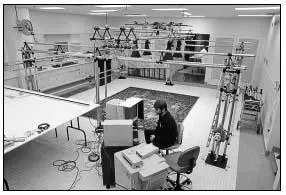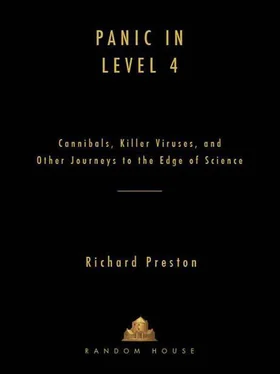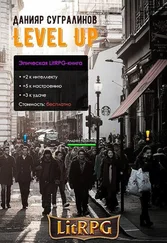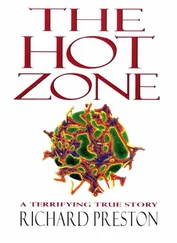
Joseph Coscia, Jr., photographing one of the Unicorn Tapestries in the wet lab. Antonio Ratti Textile Center, The Metropolitan Museum of Art.
Image © Metropolitan Museum of Art
YEARS EARLIER, I had gotten to know Gregory and David Chudnovsky. They were number theorists—they investigated the properties of numbers—and they designed and worked with supercomputers. The Chudnovsky brothers insisted that they were functionally one mathematician who happened to occupy two human bodies. I had become familiar with what American mathematicians referred to as the “Chudnovsky Problem”—the fact that, despite their stature and accomplishments, they couldn’t seem to get permanent jobs in the academic world. The Chudnovsky Problem had been partially solved, and the Chudnovsky Mathematician was working at the Institute for Mathematics and Advanced Supercomputing, or IMAS, which was operating out of a laboratory room at Polytechnic University, in downtown Brooklyn. IMAS was essentially the Chudnovskys.
Gregory Chudnovsky was now in his early fifties, a frail man with longish hair and a beard that were going gray, and sensitive, flickering brown eyes. His health had continued to be uncertain. He had myasthenia gravis, a condition that he had developed in his teenage years and that kept him in bed or in a wheelchair much of the time. David was five years older than Gregory, a genial man, somewhat on the portly side, with a cultivated manner, and he had curly graying hair and pale blue eyes that could take on a look of sadness.
At the time I first got to know the Chudnovsky brothers, they had built a powerful supercomputer out of mail-order parts. It filled the living room of Gregory’s apartment at the time, on 120th Street in Morningside Heights, near Columbia University. They said the machine didn’t really have a name, but they told me I could refer to it as “m zero,” in order to have something to call it. Gregory was then living in the apartment with his wife, Christine, who was an attorney at a midtown firm, and his mother, Malka Benjaminovna Chudnovsky, who was in declining health. Malka passed away in 2001. The Chudnovsky brothers were using their homemade supercomputer to calculate the number pi, or π, to beyond two billion decimal places. Pi is the ratio of the circumference of a circle to its diameter, and is one of the most mysterious numbers in mathematics. Expressed in digits, pi begins 3.14159…and runs on to an infinity of digits that never repeat. Though pi has been known for more than three thousand years, mathematicians have been unable to learn much about it. The digits show no predictable order or pattern. The Chudnovskys had been hoping, very faintly, that their supercomputer might see one. However, the pattern in pi may be too complex and subtle for the human mind to grasp or for any supercomputer to find. In any event, the supercomputer used a lot of electricity. In the summer, it heated Gregory’s apartment to above a hundred degrees Fahrenheit, so the brothers installed twenty-six fans around it to cool it down. The building superintendent had no idea that the brothers were investigating pi in Gregory’s apartment.
While this was going on, neither of the brothers had a permanent academic job. They were untenured senior research scientists at Columbia and were getting along on grants and consulting fees, and their wives were also contributing to the family income. Their employment problem was complex: they were a pair, yet they would need to fit into a math department as a single faculty member. In addition, they were using computers, an activity that some mathematicians regarded as unclean. And Gregory was unable to live anywhere except in a room where the air is purified with HEPA filters. (He suffered from allergies that could prove life-threatening.) He would require special care and arrangements from a math department, and it wasn’t clear how much teaching he’d be able to do.
One day the Chudnovskys were approached by a man named Jeffrey H. Lynford, who was the CEO of Wellsford Real Properties, a real estate investment firm. He and his wife, Tondra, had become fascinated with the Chudnovsky Problem and had become determined to try to solve it somehow—that is, to find jobs for the brothers. Jeff Lynford proposed trying to raise money to endow a chair of mathematics for the Chudnovskys at a university somewhere. In the end, after several years of fund-raising efforts, Jeff and Tondra Lynford gave $400,000 to Polytechnic University. This gift, along with others, including two gifts from a Dallas businessman named Morton H. Meyerson and a gift from the Wall Street investor John Mulheren, ended up being enough to partially endow the Institute for Mathematics and Advanced Supercomputing. (John Mulheren died in 2003.) Having an institute put the brothers on a more stable footing. Gregory and Christine moved to a specially modified apartment that had filtered air, in Forest Hills, and in 1999 they had a daughter, Marian.
At IMAS, the brothers set about building a new series of computers of Chudnovskian design. The latest of them was a powerful machine of a type called a cluster of nodes. It was similar in design to their original machine, m zero, but was very much more powerful. (The most powerful supercomputer today is tomorrow’s desktop machine.) The brothers ordered the parts for their new “supercomputer” through the mail. It sat inside a framework made of metal closet racks and white plastic plumbing pipes, and the structure was covered with window screens—those parts of the machine came from Home Depot. The brothers referred to their computer cluster modestly as “nothing.” Alternatively, they called it “the Home Depot thing.” “To be honest, we really call it It,” Gregory explained. “This is because It doesn’t exactly have a name.” They became interested in using It or the Home Depot thing to crack problems that had proved difficult, such as assembling large DNA sequences or making high-resolution 3-D images of works of art.
To try to make a perfect digital image of the Unicorn Tapestries sounded like an interesting problem to David and Gregory Chudnovsky. One day, David paid a visit to the Met. He left the Met carrying seventy CDs of the Unicorn Tapestries. He and Gregory planned to feed the data into the Home Depot thing and try to join the tiles together into seamless images of the tapestries. The images would be the largest and most complex digital photographs of any artwork ever made. “This will be easy,” David said to Barbara Bridgers as he left. He was wrong.
* * *
“WE THOUGHT TO OURSELVES that it would be just a bit of number crunching,” Gregory said.
But, David said, “it wasn’t trivial.”
The brothers had a fairly easy time setting up the tiles on the Home Depot thing. When they tried to fit the puzzle together, however, they found that the pieces wouldn’t join properly; the warp and weft threads didn’t run smoothly from one tile to the next. The differences were vast. It was as if a tapestry had not been the same object from one moment to the next as it was being photographed. Sutures were visible. The result was a sort of Frankenstein version of the Unicorn Tapestries. The Chudnovskys had no idea why.
David, in exasperation, called up Barbara Bridgers. “Somebody has been fooling around with these numbers,” he told her.
“I don’t think so, David. Nobody around here could do that.”
David informed her that he and Gregory would need to obtain the complete set of raw data from the Leica camera. The next day, he went to the museum and collected, from Bridgers, two large blue Metropolitan Museum shopping bags stuffed with more than two hundred CDs, containing every number the Leica had collected from the Unicorn Tapestries. There were at least a hundred billion numbers in the shopping bags.
Читать дальше









![Shin_Stark - В подземелье я пойду, там свой level подниму X [СИ]](/books/384602/shin-stark-v-podzemele-ya-pojdu-tam-svoj-level-po-thumb.webp)



